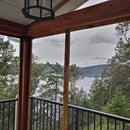Introduction: Personal Heat Exchanger
This is something I made for hiking in cold weather - if you're climbing uphill in temperatures of -20C, the lungfuls of air you suck in are naturally rather colder than freezing. This device pre-warms the inhaled air using heat from exhaled air, modelled after a residential air exchange unit.
I forgot to photograph the project during assembly, and as it's largely glued, I can't easily take it apart to rectify that - sorry.
I made two prototypes; the Mk 1 using concentric hoses and the Mk 2 (pictured above) using aluminium foil mazes. Both are based on a 3M Dual Cartridge Respirator, with Organic Vapour cartridges, from a hardware or automotive store. E.g. model P95 Series 5000.
.
Other components are random hardware
- 2 of 0.5" PVC 45 degree plumbing elbow
- 1.25" PVC pipe end cap
- 2 of aluminium foil roasting pan
- 10ft Foam tape (draught excluder)
- Hot-melt glue
- Electrical tape
Step 1: Exhaust Piping.
The PVC plumbing cap should fit fairly snugly over the original mask exit valve. Drill two 1/2 inch holes in the sides of the cap, 180 degrees apart, close to the top of the cap. You may need to carve away some of the exit valve surround - do not damage the valve itself. When finished, the cap should fit over the exit valve with the plastic elbows protruding on each side.
Step 2: Heat Exchanger Maze
The cartridge consists of a body containing activated charcoal between two layers of thick gauze, with a removable cover holding a paper filter. The maze uses both the body and cover, after removing the charcoal.
Cut away the plastic mesh and remove the gauze. Pour out the charcoal. Remove the lower gauze, then wash the cartridge body to remove any stray charcoal.
Temporarily fit the cover, and drill a 1/2 inch hole in the narrow end of body+cover to accept the 45 degree plastic elbow. The alignment is not exact - the cartridge is not at exactly 45 degrees from the mask centreline.
Using the removed gauze as a template, cut out a piece of thick foil to make layers 1 and 3 of the maze. See drawings. The foil covers about 90% of the bottom of the body, with a 5mm gap, then bends at 90 degrees to form a vertical section, then bends again to be glued along the top of the body, then again to form the exit port.
This foil will be glued to the bottom of the body, flush up to the narrow end. But first you need to block off the channels between the new inlet port and the original mask connection port. I used bits of the mask packaging with hot-melt glue.
Bend the foil and glue it into the bottom. Seal the gap between the vertical section and the sides of the cartridge body. Form some more foil into a fan-fold pattern to make a spacer to hole layer 2 halfway up the body, and glue that in place. Again using the gauze as a template, cut out layer 2 from foil and glue it in place against the sides of the body. It should be bent up slightly at the narrow end and sealed against the body. You are trying to make two adjacent air paths that don't leak into each other, or to the outside.
Make another fan-fold spacer and glue that atop layer 2, then fold the original foil back atop that to make layer 3, gluing it along the top edge of the body. Seal along the edges of the vertical section.
Cut the cover at the narrow end to extend the existing hole towards the narrow end, then block up half of the original hole - you are trying to move the hole to make the exit ports. I used plastic from the mask packaging, glued in place and taped with electrical tape. Fit the cover, bending layer 3 up to make the exit port baffle.
Step 3: Assembly
Fit the cartridges to the mask.
Assemble the plastic cap onto the exit valve, with the plastic elbows connected between the cap and cartridges, and glue everything in place. Seal all the gaps with hot-melt glue.
Cover the outside of the cartridges with strips of foam tape to act as thermal insulation. I added some to the mask and piping, too, and secured some with electrical tape.
Step 4: Use
I used the completed unit for a day's skiing over Christmas. It was about -22C at the bottom of the lift and I think -34C at the peak (with windchill). The unit worked moderately well - I certainly didn't feel like I was breathing ice, as I did without. I should really have worn a thin hood under the mask and goggles - the wind cut like a knife into the gap between the two and I think I got a bit of frostbite on my cheek.
Step 5: Mk I
Here's a couple of pictures of the Mk I prototype. This used the same 3M mask, but only one cartridge. The hose connection used a discarded juice can over the exit valve. The heat exchanger is formed by a flexible steel hose (from an oil funnel) co-axially inside a ribbed plastic hose.
Compared to the Mk II, the use of only one cartridge limited the airflow when breathing hard, and the length and limited flexibility of the hose made it difficult to move my head much.











